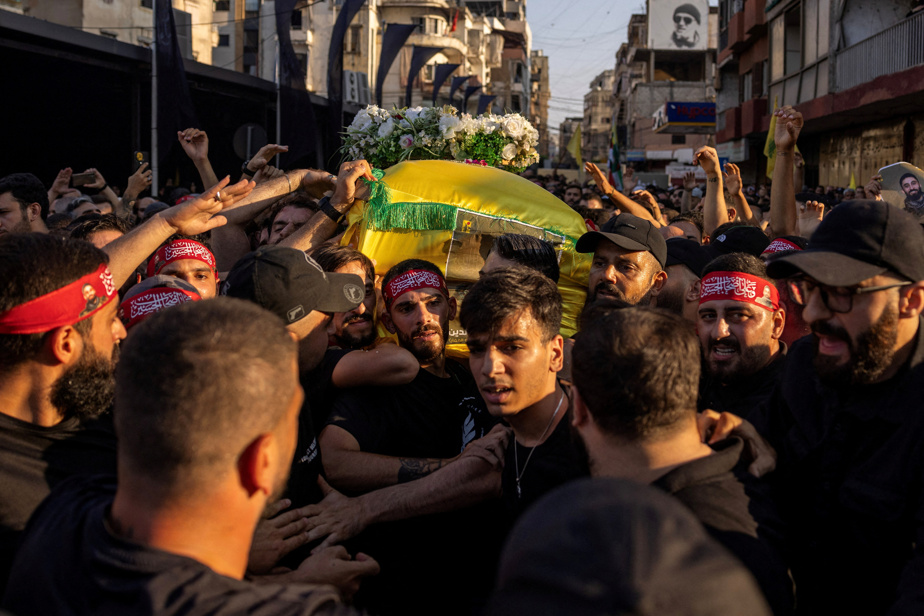(Beirut) Ten months of cross-border violence between Lebanon’s Hezbollah and Israel on the sidelines of the war in Gaza have killed several hundred fighters from the pro-Iranian movement and caused significant damage on both sides of the border, from which more than 100,000 people have been displaced.
The Lebanese Islamist movement, which has opened what it calls a “support” front for the Palestinian Hamas in the Gaza Strip, has already suffered losses greater than those in the last conflict with Israel in 2006.
Commanders killed
Israeli strikes have killed key Hezbollah commanders in recent months, including its military leader, Fouad Chokr, who was targeted on July 30 in the southern suburbs of Beirut, a stronghold of the movement that has vowed to avenge him.
In January, a commander of Hezbollah’s elite Al-Radwan unit, Wissam Tawil, was killed in an Israeli strike on his vehicle in southern Lebanon.
Two of the three commanders of the southern sectors of Lebanon were also killed: Mohammed Nasser and Taleb Abdallah.
After the 2006 war, Hezbollah divided the area where it operates militarily in the south into three sectors, each with “an integrated military formation with its own leader, its own personnel, weapons and capabilities,” according to the movement’s leader, Hassan Nasrallah.
The region south of the Litani River comprises two sectors, the first, in which the Aziz unit operates, extends from the sea to the centre of this region where Nasser was in an Israeli strike on July 3.
The second sector, where the Nasr unit operates, extends from the center of this region to the contested Shebaa Farms. This unit, whose commander Taleb Abdallah was killed in a similar strike in Jouaiyya on June 11, was the first to bomb Israel on October 8.
The third sector, extending from the north of the Litani River to the city of Sidon, constitutes the Badr unit’s area of operations.
Israel has repeatedly said it has killed other Hezbollah fighters it has called “commanders.”
Fighters killed
The violence has left at least 570 dead in Lebanon, mostly fighters from Hezbollah and allied groups, including Hamas, but also at least 118 civilians, according to an AFP tally.

PHOTO AVI OHAYON, REUTERS
Smoke rises after rockets were fired from Lebanon into the Israeli-annexed Golan Heights.
On the Israeli side, including in the annexed Golan Heights, 22 soldiers and 26 civilians were killed, according to army figures.
Hezbollah has announced the death of more than 370 fighters in Lebanon, according to an AFP tally.
Twenty-five others were killed in neighboring Syria, where Israel has for years carried out strikes against army positions and pro-Iranian fighters, also seeking to cut Hezbollah’s supply lines to Lebanon from Tehran.
About 320 of the Hezbollah fighters killed were from southern Lebanon, including about 60 from the eastern Bekaa Valley (east).
Since the end of January, more than 230 fighters have been killed. Nearly 70 percent were aged 40 or younger and six of them were aged 20 or younger, according to the movement.
A source close to Hezbollah told AFP that fewer than 300 of the group’s fighters were killed in the conflict between the Shiite party and Israel in 2006.
Hezbollah Operations
Hezbollah said it was seeking to mobilize Israeli troops in the north of the country to support its ally, Hamas, whose October 7 attack on Israel triggered a war in the Gaza Strip.
The escalation of attacks has raised fears of a wider conflict.
On August 3, the group said it had carried out 2,500 “military operations” against Israel since October.
He claimed to have targeted “border positions” 1,328 times and “military barracks” 391 times, and to have used various weapons, including artillery, rockets, “guided missiles” and “air defense weapons.”
The movement also released three videos showing surveillance drone footage taken from across the border, seen as a bank of potential targets in the event of all-out war.
The images show military positions in northern Israel and the annexed Golan Heights, as well as sensitive areas in and around the port city of Haifa.
